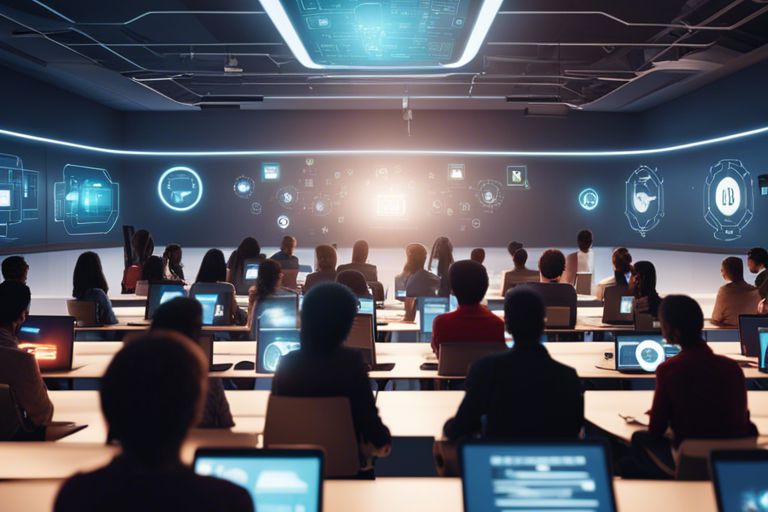It’s no secret that artificial intelligence (AI) is transforming every aspect of our lives, and education is no exception. In this era of rapid technological advancement, AI’s impact on the classroom experience cannot be overlooked. From personalized learning to real-time feedback, AI is reshaping how students learn and teachers teach. Let’s investigate into five key ways AI is revolutionizing the traditional educational system.
Enhanced Personalization
Your classroom experience is being revolutionized by artificial intelligence through enhanced personalization. AI is enabling adaptive learning systems and tailored educational content to cater to individual student needs and preferences.
Adaptive Learning Systems
On the forefront of this revolution are adaptive learning systems that use AI algorithms to analyze student data and behavior, creating personalized learning paths for each student. These systems can identify areas where a student may be struggling and provide extra support and resources tailored to their needs. By adapting to the pace and style of each student, adaptive learning systems improve learning outcomes and engagement.
Tailored Educational Content
One way AI is changing the classroom experience is through tailored educational content, where AI algorithms analyze data to personalize the material presented to students. This ensures that students receive content that is relevant and engaging to them, increasing their comprehension and retention of the material.
To further enhance the tailored educational content, AI can also provide real-time feedback to teachers on student performance, allowing for immediate adjustments in teaching strategies to better meet the needs of each student.
Intelligent Tutoring Systems
Real-time Feedback and Assessment
Feedback plays a crucial role in the learning process, and with Intelligent Tutoring Systems (ITS), students can receive real-time feedback and assessment on their progress. These systems use AI algorithms to analyze student responses and behaviors, providing instant feedback to help students understand their strengths and areas for improvement. By offering personalized guidance, ITS can adapt to each student’s pace and learning style, fostering a more efficient and tailored learning experience.
Humanizing AI-Powered Instruction
Tutoring programs powered by AI are not only revolutionizing the way students learn but also humanizing the classroom experience. These programs are designed to emulate human interaction, offering empathetic responses and personalized instruction to students. By incorporating emotional intelligence into AI-powered instruction, students feel more connected and engaged, enhancing their overall learning outcomes.
With ITS, students can receive individualized attention and support, leading to a deeper understanding of the material. Additionally, these systems can analyze student data to identify patterns and adjust instruction to meet the specific needs of each learner. This personalized approach can help boost student confidence and motivation in the learning process.
Virtual Learning Environments
Even in traditional classroom settings, virtual learning environments are revolutionizing the way students engage with educational content. These environments provide students with immersive educational experiences that transport them to different worlds, allowing for a more interactive and engaging learning process.
Immersive Educational Experiences
Learning in a virtual environment enables students to explore complex concepts in a way that textbooks and lectures cannot. By immersing themselves in virtual worlds, students can interact with the material in a hands-on manner, enhancing their understanding and retention of the subject matter. This type of experiential learning can be especially beneficial for subjects that are difficult to grasp through traditional teaching methods.
Interactive Simulations and Games
Virtual simulations and games bring learning to life in ways that were previously unimaginable. These interactive tools allow students to apply theoretical knowledge in practical scenarios, helping them develop problem-solving skills and critical thinking abilities. By engaging with Virtual simulations and games, students can see the direct impact of their decisions, making the learning process more dynamic and rewarding.
Games in the classroom are no longer just for fun – they play a crucial role in enhancing the educational experience. By incorporating elements of gamification into learning activities, educators can motivate students to actively participate and strive for success. This gamified approach can lead to increased student engagement, improved motivation, and ultimately, better learning outcomes.

Natural Language Processing
Now, let’s probe into how Natural Language Processing (NLP) is transforming the educational landscape.
AI-Driven Language Translation
On the forefront of AI in education is AI-driven language translation, which breaks down language barriers in the classroom. With the power of NLP, students can now interact with educational content in their native language, breaking down communication barriers and fostering a more inclusive learning environment. This technology not only facilitates understanding but also promotes cultural exchange and empathy among students from diverse backgrounds.
Enhanced Language Learning Capabilities
On the horizon of NLP in education lies enhanced language learning capabilities. AI-powered language learning platforms leverage NLP to provide personalized feedback, tailored language exercises, and real-time speech evaluation. This revolutionary technology adapts to individual learning styles, offering students a more engaging and effective way to master new languages.
Language learning tasks that once seemed daunting, such as pronunciation practice and grammar drills, become interactive and engaging through AI-driven platforms. Students can practice speaking, listening, reading, and writing in a supportive digital environment that provides instantaneous feedback and adapts to their progress. This innovative approach to language learning opens up new possibilities for students to achieve proficiency in a fun and efficient manner.
Automated Grading and Feedback
Reducing Teacher Workload
To reduce the burden on educators, AI tools are being increasingly used for automated grading and feedback. These systems are able to evaluate assignments, quizzes, and tests quickly and efficiently, providing students with instant feedback on their performance. This not only saves teachers valuable time but also allows them to focus on more personalized instruction and individualized support. With AI handling the grading process, educators can devote more energy to mentoring students and fostering critical thinking skills.
Increasing Feedback Accuracy
An important aspect of automated grading is its ability to provide accurate and consistent feedback to students. AI systems can analyze and evaluate assignments based on pre-set criteria, ensuring that grading is fair and unbiased. Furthermore, AI algorithms continuously learn and improve over time, enhancing the accuracy of feedback provided to students. This consistent and reliable feedback can empower students to identify their strengths and weaknesses and take steps to improve their academic performance.
Intelligent Data Analysis
Keep up with the fast-paced advancements in education technology with intelligent data analysis. By utilizing artificial intelligence, educators can gain valuable insights into student performance, engagement, and learning behaviors. This data-driven approach revolutionizes the classroom experience by enabling teachers to make informed decisions based on real-time information.
Identifying Learning Patterns and Trends
To enhance the learning experience, AI tools can analyze vast amounts of data to identify patterns and trends in student performance. By recognizing individual learning styles and preferences, educators can personalize their teaching methods to better meet the needs of each student. This personalized approach can lead to improved academic outcomes and increased student engagement.
Data-Driven Instructional Design
To optimize the effectiveness of teaching strategies, educators can leverage AI to design data-driven instructional plans. By analyzing student data, educators can identify areas of strength and weakness, allowing them to tailor their lessons to address specific learning gaps. This targeted approach can enhance the overall learning experience and support student success.
Intelligent data analysis in education empowers educators to make evidence-based decisions that are tailored to the unique needs of each student. By harnessing the power of AI, teachers can create a more personalized and engaging learning environment that maximizes student potential.
Virtual Teaching Assistants
Once again, artificial intelligence is transforming the traditional classroom experience through the introduction of Virtual Teaching Assistants. These AI-powered assistants are revolutionizing the way educators interact with students, provide feedback, and manage classroom activities.
AI-Powered Classroom Management
For educators, AI-powered classroom management systems have become invaluable tools for streamlining administrative tasks, tracking student progress, and enhancing overall efficiency. These systems can automate routine tasks like taking attendance, grading assignments, and even providing personalized feedback to students.
Enhanced Student Support Services
Enhanced student support services powered by AI are reshaping the way educators identify and address the individual needs of students. AI algorithms can analyze student performance data to identify areas where additional support may be required, allowing teachers to intervene proactively and provide targeted assistance to struggling students.
Plus, AI technologies can also offer personalized learning experiences tailored to each student’s unique learning style and pace, ultimately improving academic outcomes and fostering a more engaging educational environment.
Accessibility and Inclusion
AI-Driven Accessibility Tools
Many schools are embracing AI-driven accessibility tools to ensure that all students, regardless of their abilities, have the opportunity to excel in the classroom. These tools leverage artificial intelligence to provide real-time transcription services, text-to-speech capabilities, and image recognition technologies to help students with disabilities participate fully in class discussions and activities.
Personalized Learning for Students with Disabilities
An increasing number of educators are turning to AI to deliver personalized learning experiences for students with disabilities. AI algorithms can analyze individual learning styles and preferences, creating customized lesson plans and study materials. This tailored approach not only boosts engagement but also improves learning outcomes for students who may struggle in traditional classroom settings.
Accessibility and inclusion are at the heart of AI’s impact on the classroom, offering a world of possibilities for students with diverse learning needs. By leveraging the power of artificial intelligence, schools can break down barriers and create a learning environment where every student has the opportunity to thrive.
Teacher Professional Development
AI-Facilitated Training and Resources
For educators, staying abreast of the latest teaching methodologies and strategies is crucial for providing high-quality education. AI-facilitated training and resources offer a revolutionary approach to teacher professional development. With AI algorithms analyzing vast amounts of data on effective teaching practices, educators can access personalized feedback and recommendations tailored to their specific needs. This individualized approach allows teachers to focus on areas where they need improvement, leading to more impactful and efficient professional growth.
Enhancing Teacher Effectiveness
On the journey to becoming exemplary educators, teachers often face challenges that can hinder their effectiveness in the classroom. Development . AI tools can provide real-time feedback during lessons, helping teachers gauge student engagement levels and adjust their teaching strategies accordingly. Additionally, AI can analyze student performance data to identify areas where specific students may need extra support, enabling teachers to provide targeted interventions and support. With AI empowering educators to make data-driven decisions, teachers can enhance their effectiveness and make a more significant impact on their students’ learning outcomes.
Professional development opportunities that incorporate AI technologies not only benefit teachers but also have a ripple effect on the overall educational experience for students. By equipping teachers with the tools and insights they need to excel, AI is revolutionizing how educators approach their professional growth and ultimately transforming the classroom experience for the better.
Parent-Teacher Communication
Now, as artificial intelligence continues to transform the educational landscape, one of the most significant advancements is seen in how AI is revolutionizing parent-teacher communication in the classroom. This enhanced communication is crucial for the academic success of students and the overall well-being of the educational community.
AI-Driven Communication Platforms
Platforms powered by AI algorithms are now streamlining and improving the way parents and teachers communicate. These AI-driven platforms can provide real-time updates on student progress, behavior, and attendance, allowing for proactive intervention when needed. By analyzing data and patterns, AI can assist teachers in identifying students who may need additional support, enabling early intervention and support mechanisms.
Enhanced Parental Involvement
One of the key benefits of AI in the classroom is the ability to enhance parental involvement. Through AI-powered tools, parents can receive personalized updates on their child’s academic performance and overall well-being. This level of transparency and engagement fosters a collaborative relationship between parents and teachers, ultimately benefiting the student’s educational journey.
The increased parental involvement facilitated by AI technology can lead to more informed conversations during parent-teacher conferences, as both parties have access to real-time data and insights. This promotes a holistic approach to student development, where teachers and parents can work together to support the individual needs of each student.
Cybersecurity and Privacy
After the rapid integration of artificial intelligence technologies in educational settings, cybersecurity and privacy have become paramount concerns. Educational institutions are responsible for safeguarding student data and privacy while utilizing AI tools to enhance learning experiences.
Protecting Student Data and Privacy
Protecting student data and privacy is crucial in the age of AI-driven education. Schools and edtech companies must ensure that sensitive information such as academic records, personal details, and learning patterns are secure from unauthorized access. Implementing robust encryption techniques and regularly updating security protocols can safeguard student data from cyber threats.
Ensuring Secure Online Learning Environments
Privacy is important in creating secure online learning environments. With the increasing use of AI-powered tools like virtual classrooms and personalized learning platforms, it is imperative to prioritize data protection measures. Educational institutions need to invest in advanced security technologies to prevent cyber attacks and ensure that students can learn in a safe digital space.
Plus, ensuring secure online learning environments goes beyond just protecting student data. It also involves educating teachers, students, and staff about cybersecurity best practices and promoting a culture of digital responsibility within the educational community.
Cost-Effective Education
Reducing Educational Expenses
The use of Artificial Intelligence (AI) in the classroom is significantly reducing educational expenses. AI-powered systems can automate various administrative tasks that would otherwise require significant human resources. This automation leads to cost savings in manpower and allows educational institutions to allocate their funds more efficiently.
Increasing Resource Allocation Efficiency
Cost-effective education is achieved through increasing resource allocation efficiency. AI algorithms can analyze data to identify patterns and make predictions, helping educators make informed decisions about where to allocate their resources. By optimizing resource allocation, institutions can provide better educational experiences for students while maximizing their budget.
The integration of AI in resource allocation processes has the potential to revolutionize how educational institutions manage their funds, leading to improved educational outcomes at reduced costs.
Future of Workforce Development
Despite the rapid advancement of AI technology, there is a growing need to prepare students for the future workforce, which will be significantly influenced by AI and automation. As industries continue to adopt AI solutions, it is vital to equip students with the necessary skills to thrive in AI-driven careers.
Preparing Students for AI-Driven Careers
Students must be exposed to AI technologies and concepts from an early age to understand their potential and impact on various industries. By integrating AI education into the curriculum, students can develop the technical skills required to work alongside AI systems effectively. This preparation will enable them to adapt to the changing job market and take advantage of new opportunities in AI-driven fields.
Fostering Essential Skills for the Future
With AI taking on routine tasks, the future workforce will need to focus on developing vital skills such as critical thinking, creativity, adaptability, and emotional intelligence. These skills are highly valued in roles that require human interaction, problem-solving, and strategic decision-making. By emphasizing the development of these skills, students can differentiate themselves in a competitive job market and thrive in positions that require human-centered capabilities.
The ability to think critically and creatively, adapt to new situations, and empathize with others will be crucial in a future where AI plays a significant role in the workforce. Students who can combine technical expertise with vital skills will be well-positioned to succeed in AI-driven careers, contributing positively to innovative solutions and collaborative work environments.
1. Personalized learning experiences tailored to each student’s needs.
2. Enhances student engagement and participation in learning activities.
3. Automates administrative tasks for teachers, saving time and resources.
4. Provides real-time feedback to students for improved understanding.
5. Supports teachers in identifying students at risk of falling behind.
6. Promotes collaboration and communication among students and educators.
Summing up
To wrap up, AI technology is transforming the traditional classroom experience in various ways, making learning more personalized, engaging, and efficient. By leveraging AI-powered tools like virtual tutors, adaptive learning platforms, and intelligent grading systems, educators can cater to each student’s individual needs and enhance their learning outcomes. The integration of AI in education is paving the way for a more effective and inclusive learning environment, setting the stage for a brighter future where technology plays a significant role in shaping the minds of tomorrow.
FAQ
Q: How is AI revolutionizing the classroom experience?
A: AI is transforming the classroom experience through personalized learning, virtual tutors, automated grading, intelligent content, and data-driven insights.
Q: What is personalized learning in the context of AI?
A: Personalized learning involves tailoring educational content and pace to suit each student’s individual needs and learning style, made possible by AI algorithms that analyze data and adapt accordingly.
Q: How do virtual tutors enhance the learning process?
A: Virtual tutors equipped with AI can provide students with immediate feedback, round-the-clock assistance, and personalized support, helping them grasp concepts more effectively.
Q: How does AI facilitate automated grading?
A: AI streamlines the grading process by automatically scoring assignments, quizzes, and tests based on pre-set criteria, saving teachers time and ensuring faster feedback for students.
Q: In what ways does AI enable intelligent content creation?
A: AI helps educators develop customized learning materials by analyzing student performance data, creating adaptive content, and integrating interactive elements for a more engaging learning experience.
Q: How can AI provide data-driven insights to educators?
A: By collecting and analyzing vast amounts of data on student performance and behavior, AI can generate valuable insights for educators to identify trends, adapt teaching strategies, and make informed decisions about student progress.
Q: What are the potential benefits of AI in the classroom?
A: The use of AI in education can lead to increased student engagement, improved learning outcomes, more efficient teaching practices, greater access to personalized instruction, and enhanced overall educational experiences for both students and teachers.




